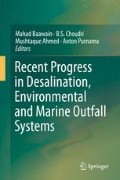Abstract
The energy required to operate coastal thermal desalination plants and thus the relevant costs are greatly affected by coastal hydrodynamics. A multi-layered hydrodynamic model was developed in this study for a coastal area in the United Arab Emirates to investigate such an effect. The simulation was carried out using a curvilinear grid model with sigma layers in the vertical direction which incorporates the transport of salt and temperature interactively with water dynamics. Several simulations were carried out to investigate the impact of the brine and warm cooling water discharges released from the desalination plant as well as other nearby industrial facilities using a three-dimensional advection-dispersion surface formulation. The model output was used to determine suitable locations and configurations for water intakes as well as outlets to maintain the temperature and salinity of the water introduced to the plant at optimum acceptable levels, so that maximum efficiency and minimum operation cost are achieved. A number of alternative scenarios were also considered to fully assess the problem. This includes extreme desalination operation scenarios in summer and winter, possible maximum release of warm water by other industrial facilities, and scenarios of the future expansion of plant production. Three alternatives were investigated including shifting the intake to new offshore locations, moving the outfall away from the intake area, and having the outfall discharge its effluent into further and deeper zones. Cost analysis was carried out for two scenarios to evaluate the operation cost in terms of chemical and energy cost. The first alternative that involved shifting the intake location about 1 km offshore was found to be the best option as it achieved the maximum reduction of chemical and energy costs for all tested scenarios when compared with the existing configuration. 2.5 % of the total annual cost, equivalent to US $1.2 million is saved, taking into consideration a major expansion to the existing industrial facilities which will produce 10 times the existing effluent levels.
Access this chapter
Tax calculation will be finalised at checkout
Purchases are for personal use only
References
Admiralty Tide Table (ATT) (2001) Hydrographer of the navy, vol 3. United Kingdom
Azam MH, Elshorbagy W, Nakata K (2006) Three dimensional modeling of the Ruwais Coastal Area of United Arab Emirates. ASCE/J Waterway Port Coast Ocean Eng 132(6):487–495
Elshorbagy W, Azam M, Taguchi K (2006) Hydrodynamic characterization and modeling of the Arabian Gulf. ASCE/J Waterway Port Coast Ocean Eng 132(1):47–56
Elshorbagy W, Azam MH, Nakata K, Terasawa T (2008) Temperature-salinity field of the shallow shelf of southern Arabian Gulf. Far East J Ocean Res 1(2–3):99–126
Elshorbagy W, Azam MH, Al-Hakeem A (2013) Temperature-salinity modeling for Ruwais Coast, United Arab Emirates. Mar Pollut Bull 73:170–182
Petroleum Port Authority (2003) Ruwais refinery division, TAKREER Company, ADNOC, Abu Dhabi, United Arab Emirates
Author information
Authors and Affiliations
Corresponding author
Editor information
Editors and Affiliations
Additional information
List of Figures
Fig. 16.1 The Arabian Gulf and the study area
Fig. 16.2 Comparison of measured and simulated water level near the study area
Fig. 16.3 Comparison of the salinity results considering the three different scenarios at the desalination intake in winter
Fig. 16.4 Comparison of the temperature results considering the three different scenarios at the desalination intake in winter
Rights and permissions
Copyright information
© 2015 Springer International Publishing Switzerland
About this chapter
Cite this chapter
Elshorbagy, W.E., Basioni, A.H. (2015). Impact of the Coastal Intake Environment on the Operating Conditions of Thermal Desalination Plants: A Case Study in the United Arab Emirates. In: Baawain, M., Choudri, B., Ahmed, M., Purnama, A. (eds) Recent Progress in Desalination, Environmental and Marine Outfall Systems. Springer, Cham. https://doi.org/10.1007/978-3-319-19123-2_16
Download citation
DOI: https://doi.org/10.1007/978-3-319-19123-2_16
Publisher Name: Springer, Cham
Print ISBN: 978-3-319-19122-5
Online ISBN: 978-3-319-19123-2
eBook Packages: Earth and Environmental ScienceEarth and Environmental Science (R0)

